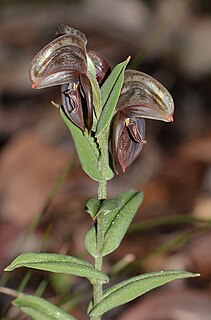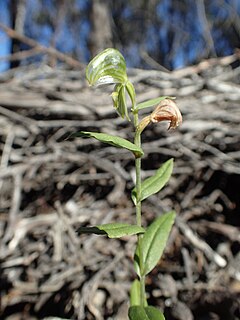
Pterostylis hamiltonii, commonly known as the red-veined shell orchid, is a species of orchid endemic to the south-west of Western Australia. As with similar orchids, the flowering plants differ from those which are not flowering. The non-flowering plants have a rosette of leaves but the flowering plants lack a rosette and have a single flower with leaves on the flowering spike. This greenhood has a green and white, striped flower with reddish-brown markings and forms colonies, sometimes of thousands of plants.

Pterostylis scabra, commonly known as the green-veined shell orchid, is a species of orchid endemic to the south-west of Western Australia. As with similar orchids, the flowering plants differ from those which are not flowering. The non-flowering plants have a rosette of leaves but the flowering plants lack a rosette and have a single flower with leaves on the flowering spike. This greenhood has a white flower with green and pale brownish-fawn stripes and a long, curved protruding labellum. It is found in inland areas between Kalbarri and Esperance.
Pterostylis allantoidea, commonly known as the shy greenhood is a species of orchid which is endemic to the south-west of Western Australia. It has a large rosette of leaves at the base of a flowering spike and a single white flower with green or reddish-brown stripes.
Pterostylis ciliata, commonly known as the hairy rufous greenhood, tall rusthood or hairy rustyhood is a plant in the orchid family Orchidaceae and is endemic to the south-west of Western Australia. It has a relatively large rosette of leaves at its base and up to eight or more green and brown flowers which lean forward and have a small, fleshy, insect-like labellum covered with hairs.

Pterostylis concava, commonly known as the pouched greenhood or cupped banded greenhood, is a plant in the orchid family Orchidaceae and is endemic to the south-west of Western Australia. The plants either have a rosette of leaves in the years when not flowering or stem leaves on a flowering spike. When flowering, it has up to ten or more flowers which are dark reddish-brown, sometimes green and white with deeply cupped lateral sepals. It is an uncommon orchid, mostly found between Bindoon and Mount Barker.
Pterostylis frenchii, commonly known as the tuart rufous greenhood, or tuart rustyhood is a plant in the orchid family Orchidaceae and is endemic to the south-west of Western Australia. Both flowering and non-flowering plants have a relatively large rosette of leaves. Flowering plants also have up to twelve white and green or white and brown flowers which lean forward and have a small, fleshy, insect-like labellum.
Pterostylis insectifera, commonly known as the insect-lipped rufous greenhood, or leaden rustyhood is a plant in the orchid family Orchidaceae and is endemic to the south-west of Western Australia. Both flowering and non-flowering plants have a relatively large rosette of leaves. Flowering plants have a similar rosette and up to eight or more flowers which have long, stiffly-held lateral sepals and a protruding, insect-like labellum.

Pterostylis leptochila, commonly known as the Ravensthorpe rufous greenhood or narrow-lipped rustyhood is a plant in the orchid family Orchidaceae and is endemic to the south-west of Western Australia. Both flowering and non-flowering plants have a relatively large rosette of leaves. Flowering plants also have up to five large translucent white flowers with olive green and brown lines and markings and a narrow, insect-like labellum.
Pterostylis macrocalymma, commonly known as the large-hooded rufous greenhood or Murchison rustyhood is a plant in the orchid family Orchidaceae and is endemic to the south-west of Western Australia. Both flowering and non-flowering plants have a relatively large rosette of leaves. Flowering plants also have up to ten or more white flowers with bold green or pale brown lines and a broad spoon-shaped, insect-like labellum.
Pterostylis macrosceles, commonly known as the slender rufous greenhood is a plant in the orchid family Orchidaceae and is endemic to the south-west of Western Australia. Both flowering and non-flowering plants have a relatively large rosette of leaves. Flowering plants also have between four and eight white flowers with green brown lines and small, insect-like labellum. It is distinguished from other Western Australian greenhoods by the unusually long thread-like tips on its sepals.
Pterostylis picta, commonly known as the painted rufous greenhood or painted rustyhood is a plant in the orchid family Orchidaceae and is endemic to the south-west of Western Australia. Both flowering and non-flowering plants have a relatively large rosette of leaves. Flowering plants also have up to seven large translucent white flowers with green and brown stripes and markings and a fleshy, insect-like labellum.
Pterostylis platypetala, commonly known as the broad-petalled snail orchid, is a species of orchid endemic to the south-west of Western Australia. It has a rosette of leaves and when flowering, a single green and white flower with relatively wide petals. In ideal conditions it can form colonies of hundreds of plants and often grows under melaleucas on the edge of winter-wet areas.

Pterostylis roensis, commonly known as the painted rufous greenhood or dark rustyhood is a plant in the orchid family Orchidaceae and is endemic to the south-west of Western Australia. Both flowering and non-flowering plants have a relatively large rosette of leaves. Flowering plants also have up to six green or brown to blackish flowers with translucent white panels and a dark brown, fleshy, insect-like labellum.
Pterostylis rogersii, commonly known as the curled-tongue shell orchid, is a species of orchid endemic to the south-west of Western Australia. As with similar orchids, the flowering plants differ from those which are not flowering. The non-flowering plants have a rosette of leaves but the flowering plants lack a rosette and have a single flower with leaves on the flowering spike. This greenhood usually has a white and reddish-brown striped flower with a long, curved labellum and is found along the south coast between Binningup and Esperance.

Pterostylis sargentii commonly known as the frog greenhood, is a plant in the orchid family Orchidaceae and is endemic to the south-west of Western Australia. It is a relatively common orchid which has up to six relatively small, white flowers with green or brown stripes and a fleshy, three-part, frog-like labellum. Non-flowering plants have a rosette of leaves on a short stalk.
Pterostylis sinuata, commonly known as the Northampton midget greenhood or western swan greenhood, is a species of orchid endemic to the south-west of Western Australia. Both flowering and non-flowering plants have a rosette of leaves lying flat on the ground and flowering plants have up to twenty yellowish-green flowers. It is only known from a small area between Northampton and Kalbarri.
Pterostylis spathulata, commonly known as the spoon-lipped rufous greenhood or Moora rustyhood is a plant in the orchid family Orchidaceae and is endemic to the south-west of Western Australia. Both flowering and non-flowering plants have a relatively large rosette of leaves. Flowering plants also have up to ten or more white and green or brown flowers with fine, upturned tips on the lateral sepals and a spoon-shaped, insect-like labellum.
Pterostylis brevichila, commonly known as the dwarf shell orchid, is a species of orchid endemic to the south-west of Western Australia. As with similar greenhoods, the flowering plants differ from those which are not flowering. The non-flowering plants have a rosette of leaves flat on the ground but the flowering plants have a single flower with leaves on the flowering spike. In this species, the flower is small and white with brown stripes and is similar to P. aspera but smaller in stature.
Pterostylis exserta, commonly known as the exserted rufous greenhood, is a species of orchid endemic to the south-west of Western Australia. Both flowering and non-flowering plants have a large rosette of leaves flat on the ground and flowering plants have up to seven pale, transparent green and white flowers with brownish lines.

Pterostylis karri, commonly known as the karri snail orchid, is a species of orchid endemic to the south-west of Western Australia. Both flowering and non-flowering plants usually have a small rosette of leaves and flowering plants have a single green and white flower with unusually long, erect lateral sepals. Like some similar greenhoods, it often forms dense colonies.







